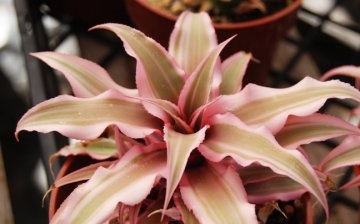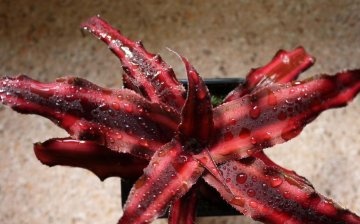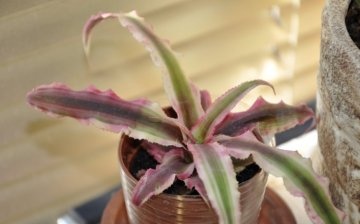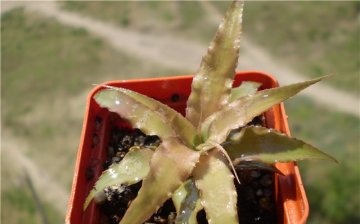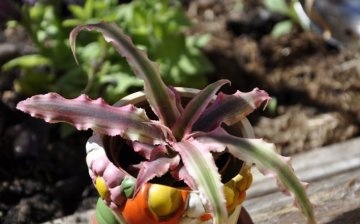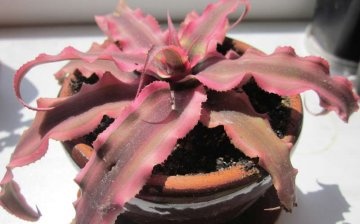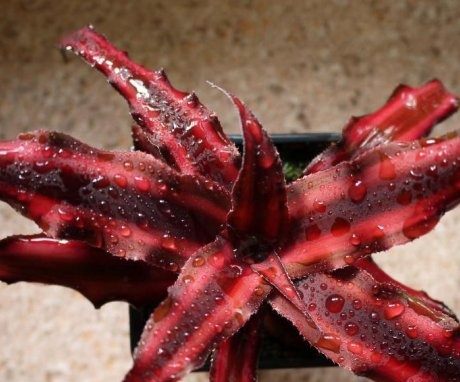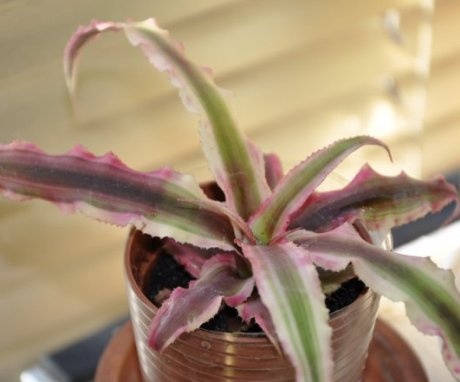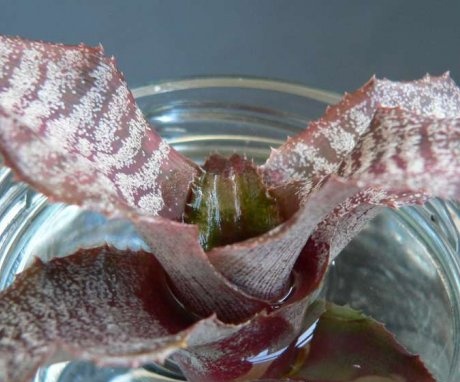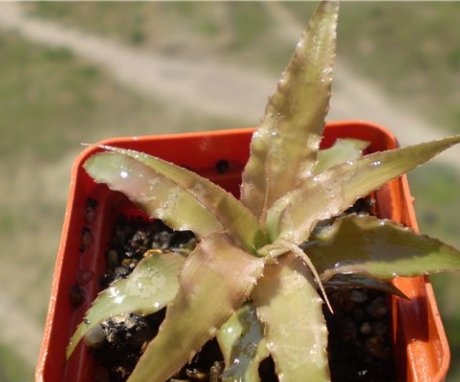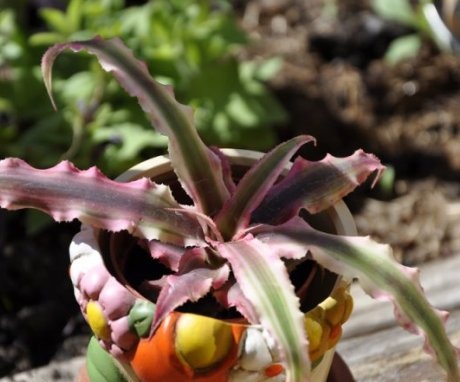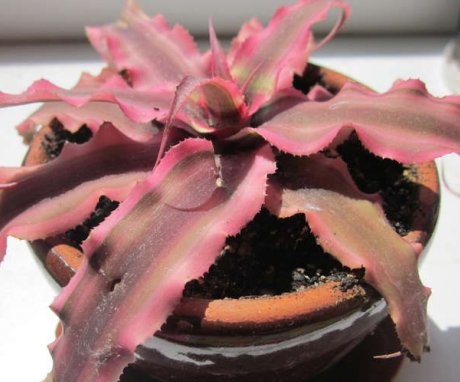Cryptantus - an exotic houseplant in your home
An interesting plant called cryptantus appeared in our area relatively recently. Its unusual appearance attracts attention - spreading leaves and a modest, eternally hiding flower. The bright, variegated color of cryptantus will adorn any windowsill or greenhouse.
The plant is sometimes compared to an octopus, it looks so impressive in large tubs. It is very easy to grow this miracle of nature. However, it should be provided with proper conditions and a minimum care... This and much more will be discussed in the material for experienced growers.
Content:
- Features of the structure of cryptantus
- Types and varieties of the "Brazilian star"
- How to propagate cryptantus
- Planting a plant
- Cryptantus care
- Diseases and pests
Features of the structure of the cryptantus
The plant belongs to the Bromeliad family, native to Brazil, its eastern part. Another popular name is the earthen star. It is a small bush, reaching a height of 20-30 cm, depending on the habitat and species. Root system poorly developed, superficial. Cryptantus can be grown as an epiphytic plant - on snags and stones. The stem is short or absent altogether. Leaves leathery, narrow, collected in rosettes.
The color of the green is interesting - it can vary from silvery green to bright brown, red, brown, chocolate and pink.
However, not only the color of the leaves attracts attention, but also their pattern. Wavy, transverse or straight vertical lines cover the leaf. Moreover, the patterns always have a contrasting shade against the general background. The shape of the leaves is carved, wavy at the edges.
The flowers of the plant are inconspicuous against the background of brightly colored leaves. Their feature is the ability to hide in greenery and not show up. The color of the inflorescences is often white, less often creamy white. Cryptantus is grown not for the sake of flowering, but for the rich color of the leaves and their unusual shape. The Brazilian Star prefers warm, humid areas with diffused sunlight. Before growing cryptantus, it's worth understanding its species. Choose the variety you like and get down to business.
Types and varieties of the "Brazilian star"
In nature, there are more than 20 types of cryptantus, but only a few are grown at home. Their characteristic feature is a height that reaches 20 cm and less often 30 cm. In nature, larger specimens can be found.
There are 5 types of cryptantus:
- Bromeliad - the species is distinguished by characteristic stripes on the leaves. They are of different shades, the general background of greenery varies from bronze to red with a green undertone. Lines adorn the leaf with three contrasting colors - green, red and white. Inflorescences are white, inconspicuous. The leaves reach 20 cm in length and 4-5 cm in width. The most famous variety of this species is Tricolor.
- Cross-striped - already from the name it is clear that the species differs from others. Zigzag yellow or white lines appear on the general green background of the leaf. The greenery is covered with whitish scales at the base. The flowers are white, small, hiding in the outlet. The most common varieties of this species are Viridis and Fuskus.The length of the leaf reaches 20 cm, the width is small - 2-2.5 cm.
- Foster - a plant of this species is distinguished by an unusual, contrasting color of the leaves. Wavy silver stripes adorn the dark brown background. Inflorescences are white, inconspicuous. The lower part of the leaf is covered with scales, which is characteristic of cryptanthus. The shape of the greenery is wavy at the edges, jagged. The length of the leaf reaches 30-40 cm, in width - 4 cm.
- Stemless - the type of cryptantus is distinguished by a very short stem or its absence. The leaves are green, narrow, without any striking differences from their counterparts. The lower part of the greenery is covered with scales. Inflorescences are white, inconspicuous. The most interesting variety is "Ruber". The leaves take on a bright red hue with a chocolate undertone. It looks very impressive. Also distinguish "Argenteus" and "Akaulis". The leaves of these varieties have a green, juicy hue.
- Two-striped - the view differs from others in the type of stripes that decorate the leaf longitudinally. The general background of the greenery will vary from green to pink depending on the variety. 2 stripes are usually yellow or white, sometimes red or brown. Flowers are white, very rare. Interestingly, this type of cryptantus is no longer found in nature. A common variety is Pink Starlight.
The type and variety is chosen depending on preferences and taste. Any type of cryptanthus will be an exquisite decoration for a room or greenhouse. Having decided on which plant will grow, you should take into account the way it breeding and methods landing.
How to propagate cryptantus
The growth rate of the plant will depend on how the "earth star" is born. Usually, a ready-made bush is purchased in a specialized store. And sometimes cryptanthus is grown seedsthat much longer. What is the preferred breeding method? Let's figure it out in order.
Seeds:
- In order to grow a plant from seeds, certain conditions must be created. First of all, the temperature regime.
- The room should be pretty hot - 22 ° -25 °. In a container closed with a film, the temperature regime should not fall below 30 °.
- A high degree of humidity and warmth will promote the emergence of young sprouts.
- Growing cryptanthus from seeds is problematic due to high temperatures, but this method is considered to be the most "healthy", the plant grows strong and is less susceptible to disease.
It should be borne in mind that cryptantus grows slowly, regardless of the species and variety. In addition to seeds, a natural miracle can be propagated by lateral processes.
Side shoots:
- This breeding method is the most popular and simplest. The life cycle of a plant ends after flowering.
- The main stem dies off, and lateral buds are formed on it, which germinate and give lateral shoots.
- So they are separated from the main bush for reproduction. This should be done when the shoot gives roots.
- Young shoots are placed in a separate container and covered with foil for adaptation in the substrate and better germination.
The second method will become the most accessible and simplest. But sophisticated growers will love the seed growing method. For good growth and development of the plant, it is important to provide it with a good substrate and climate when planting.
Planting a plant
Planting a plant with seeds is best done in spring or in August when propagating by side shoots. For better germination, it is necessary to take into account some of the nuances and growing conditions.
For cryptantus, warm places with a high degree of air humidity are chosen.
East or west windows will do. The plant should not be exposed to direct sunlight. It loves scattered rays. Therefore, the south side is not suitable for him. The container with the sprout should be on a warm surface - a special stand or a tall shell. A window sill is not a very suitable option, since it is cold on it in winter. It is important not to overcool the soil.The container for the plant is chosen shallow, since the root system is small, shallow.
Plant soil:
- The substrate for cryptanthus is easy to compose yourself. It will include a mixture of leafy, sod land, humus, peat and sand. The proportion of parts is equal.
- Many people only use turf, peat and sand. Of all types of peat, it is desirable to give preference to sphagnum.
- In specialized garden centers, you can purchase a ready-made substrate for plants of the Bromeliad family.
Lighting is one of the main conditions cultivation... It should be bright and diffused at the same time. In the early stages of cultivation, cryptantus needs 12 hours of daylight. Direct sunlight should not fall on the leaves of the plant. If the lighting is not enough, various problems will appear in the form of twisted leaves with spots.
Providing all the conditions for growing, and planting the plant in a good substrate, it will not bring much trouble. After all, all problems begin from the wrong place and violation of growing conditions.
Cryptantus care
The plant is quite unpretentious in terms of watering and feeding. The main thing here will be adequate lighting, warmth and humidity.
Watering the plant:
- During the growing season - from April to August - cryptantus must be watered abundantly.
- It is not necessary to fill it before the formation of boggy, otherwise root rot will appear.
- The substrate layer is not high, therefore watering moderate but frequent.
- Use settled, warm water.
- In the summer, if possible, water with rainwater.
- The water should be poured into the soil, not into the outlet.
- Sprinkling procedures can be carried out, but not often. Better to spray the air around to raise the humidity level.
- The leaves are periodically wiped with a damp cloth.
Top dressing can be done twice a month mineral fertilizers for the Bromeliads. However, the plant can do just fine without them, if the soil was initially correctly compiled. In winter, watering and fertilization is limited. Watering - once every three weeks, no feeding is carried out.
The transplant is carried out in the spring as needed or for breeding purposes.
If the roots have grown, there is not enough space in the container, you can transplant cryptanthus into a more spacious flowerpot. The transplant is carried out rarely, once every 2-3 years. In addition to caring for an overseas flower, you should inspect the plant for the appearance pests.
Diseases and pests
Problems in growing cryptantus can arise due to improper growing conditions. For example:
- Pale brown spots on greenery are caused by sunburn. That is, rule number one is violated - you cannot keep the plant in direct sunlight.
- Dry tips of foliage appear due to dry air, which again indicates a violation of the conditions of maintenance and care.
- Root rot appears from excess moisture. Excessive watering, waterlogged soil will lead to the death of the plant.
From peststhat usually attack cryptantus are:
- Whitefly. Whitefly must be fought with insecticides. Processing is carried out repeatedly with a break of a week. They use "Aktellik", "Aktara", "Kinmiks". It is difficult to drive out a whitefly using folk methods, as a rule, it does not go away.
- Shield. The scabbard is cleaned from the sheet, that is, you need to remove the scales, otherwise the fight against the pest will be useless. Use the same chemicals or alcohol-soap solution to fight.
- Spider mites and mealybugs. They are removed from the plant and treated with soapy water. For severe lesions, chemical preparations are always used.
Pests appear due to the microclimate that cryptanthus needs. High temperature and humidity are excellent conditions for whitefly and other pests to emerge. In open ground, growers rarely encounter such problems.Changes in temperature, natural ventilation - all this is not like parasites. However, creating natural conditions at home is problematic.
Always inspect the plant on time, follow the rules of care and growing conditions. In this case, it will be possible to grow a beautiful and unusual cryptantus - a piece of Brazil in your home!
More information can be found in the video:



